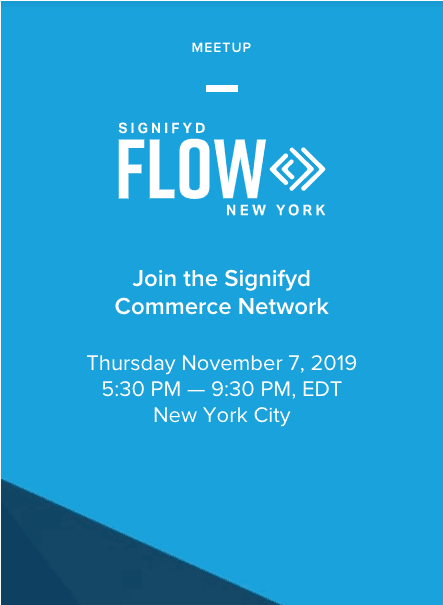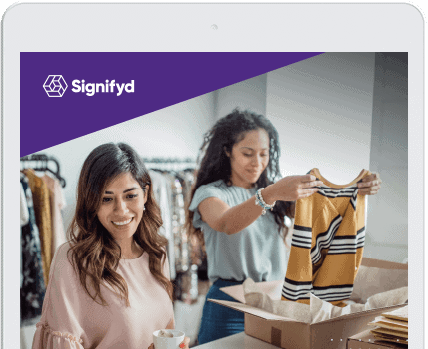From the stage where Stance Chief Revenue Officer Paul Zaengle was sitting recently, he could see the entire evolution of the ecommerce industry — from the Wild West of online-shopping-as-a-novelty to the data-driven, marketing-dominated reality of today.
Granted, it’s been a short history, but that fact alone makes all the more remarkable the changes that Zaengle covered in a wide-ranging conversation with more than 50 retail professionals at FLOW San Diego.
Zaengle had come to the stage in a trendy downtown San Diego restaurant for Signifyd’s most recent FLOW event, a chance for forward-thinking retailers to gather to educate, commiserate, socialize, network and puzzle over the answers to some of the industry’s most vexing challenges.
“I love that we’re all here tonight,” Zaengle said over dinner to a room of representatives from Rite Aid, Samsung, Organifi, Turtle Bay, Bouqs, Eye of Love and GovX among others. “I love the networking that’s happening and that is going to happen.”
Zaengle offered plenty of networking fodder, covering a career that includes key roles at Ralph Lauren, lululemon, Columbia and now Stance, the buzzy seller of creatively designed, high-quality socks and underwear.
Answers to questions about keeping up with consumers’ increasing expectations
The San Diego retail community pulled its weight, too, during an hour-long conversation filled with audience questions about consumers’ rising expectations for fast delivery, stores as media channels, the risks of discounting as a strategy, Amazon as friend or foe, affiliate deals with influencers and on and on.
The individual answers Zaengle provided were insightful as distinct pieces of advice. But taken together they produced a larger framework for retailers to work within.
Sure, it’s common to talk about best practices — don’t undervalue mobile, build strong omnichannel, break down silos, focus on experience — but the reality is that few enterprises are able to focus on improving all areas at once.

The evening will feature a fireside chat with Meg Bedford, VP, marketing & customer experience at TUMI, followed by drinks and dinner with East Coast peers.
Bedford is a leader in building omnichannel strategies for leading fashion, luxury, retail and beauty companies. She has deep digital marketing experience with leading companies including Pat McGrath and Tom Ford.
Request a seat to participate in a rare opportunity to network, learn and socialize with some of the leading lights in retail today.
Zaengle’s career illustrates the point. He’s worked at some of the biggest and most recognized names in retail. And each had distinct strengths when he arrived. They were at different stages of maturity in terms of ecommerce or brand awareness. They sold different products, appealed to different audiences, or at least different wants and needs among consumers. They had different goals. Different visions of what success means.
And so, the conventional wisdom about best practices didn’t always apply — at least not immediately.
Take Stance, an enterprise that started its life as a wholesaler before expanding into selling directly to consumers through retail stores and online. Among its strengths is the community it has built around its products.
Artists, pop culture figures, athletes and sports leagues collaborate with the company on designs and often organically help build a customer base that is more like a fan base. Though it’s origins were not direct-to-consumer, Stance is considered among the new breed of digital-native retailers that are blazing a new trail in the industry.
Can other retailers co-exist in a world with Amazon?
Much of the discussion centered on Amazon, as it often does in ecommerce circles these days. The audience asked Zaengle how they can coexist with the ecommerce giant. If you’re a retailer with the right kind of products, Zaengle said, you can take on Amazon by differentiating your business from the competition.
“How can you compete?” Zaengle said. “What can you differentiate?” Stance, for instance, launched a subscription service to offer a different way to buy. It’s experimenting with customization programs through which its socks become an even more personal reflection of their wearer.
“I’ve heard that half of Oakley’s ecommerce business is custom product,” he said, referring to the sunglasses brand, “And Nike ID, you’re all very aware of. A lot of brands have custom programs. That could be a tactic that helps you compete.”
Or how about delivery and keeping up with consumer demands for two-day, one-day, one-hour fulfillment? Again, if you’re a retailer with the right characteristics, there are ways you can meet rising consumer expectations.
“I think that’s a great solution,” Zaengle said in response to a representative of an online florist at FLOW who proposed opening stores in certain neighborhoods to have product closer to delivery addresses and partnering with PostMates for delivery.
A great solution, but again, not for every retailer.
“If you have an AOV (average order value) and you have enough margin in that sale to upgrade shipping, then absolutely,” Zaengle said. “That’s how I would compete. How can I get it there faster? Can I make shipping free?”
But fast shipping is expensive. And for retailers who have small margins or margins that are under increasing pressure, he said, improving shipping times might not pencil out.
Which begins to get at the other big takeaway from Zaengle’s hour-long interactive chat: All that talk about testing and measuring and turning to the data to make decisions? It’s every bit as important as everyone says it is.
And there, Zaengle said, the room full of ecommerce professionals was already in a good place. Ecommerce has always been about data. For one thing, it’s been easier historically to collect data from digital shopping trips than from trips to a brick-and-mortar store.
Data is crucial for brick-and-mortar success
More and more, the same principles from ecommerce are being applied to physical retail — and in fact, Zaengle noted, the two really can’t be separated. When Signifyd Senior Vice President Marketing & Alliances Indy Guha asked Zaengle what role data played in choosing locations for physical Stance stores, for instance, Zaengle said online data is crucial to figure out where to put brick-and-mortar stores.
“So we lead with our ecommerce data when we make store location decisions,” he said. “We use ecommerce sales and traffic as a proxy for brand awareness. When we put a store in an area where we have brand awareness, we have greater success.”
And the strategy creates something of a virtuous circle. Zaengle said that the ecommerce side of the business grows faster in areas where Stance opens stores.
Stance’s data-driven thinking reflects a combination of digital and physical metrics. Zaengle pointed out that while ecommerce sales by geography can guide a decision about where to place a store, it’s not going to pinpoint the exact location. For that, Stance turns to work that sounds a little more old-school.
“We put a person on the corner and we literally, manually with an app, count traffic,” Zaengle said, using New York as an example. “How many people are walking down Broadway compared to the Flatiron District?”
Those numbers can then be compared to traffic in front of existing Stance stores to provide an indication of what kind of sales could be expected in those locations.
“There is still an art to it,” he said. And because it’s not an exact science, Zaengle suggests running tests of physical stores by signing short-term leases.
Test and measure. Test and measure.
It is a solid piece of advice. One that is likely to stand the test of time. We’ll know for sure in 20 years or so when some other retail leader is on some other downtown stage recounting the evolution of ecommerce and offering advice on how to prosper given what’s ahead.
Photo by Bauman Photographers







